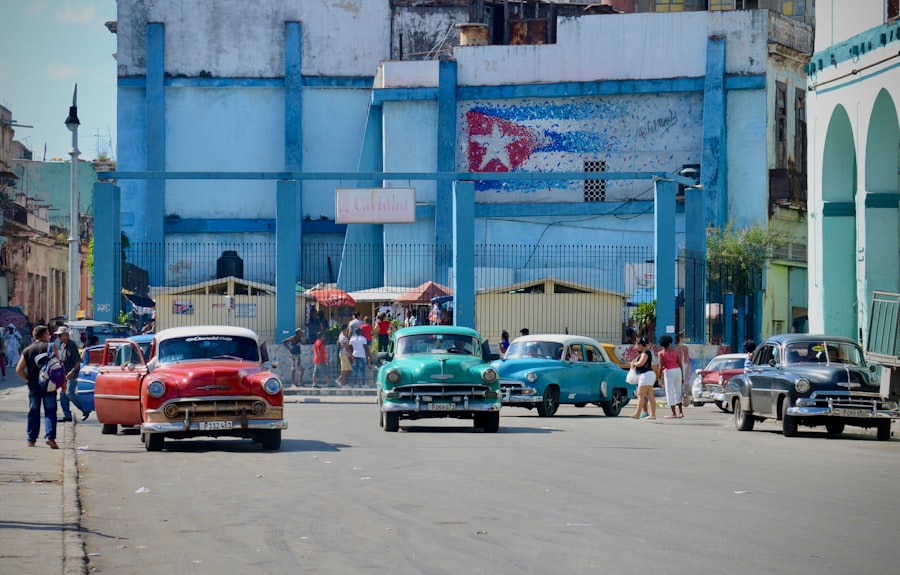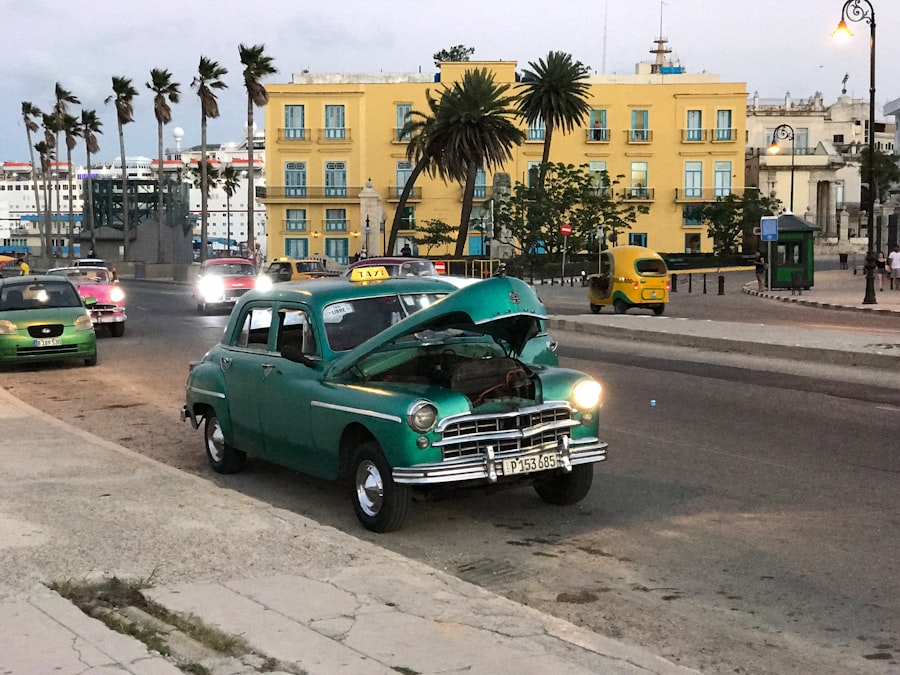The Cuban Missile Crisis, which unfolded in October 1962, stands as one of the most critical moments in the history of the Cold War. This tense confrontation between the United States and the Soviet Union brought the world to the brink of nuclear war, highlighting the precarious balance of power during a time when both superpowers were armed with devastating nuclear arsenals. The crisis was not merely a military standoff; it was a complex interplay of political maneuvering, ideological conflict, and the ever-present threat of annihilation.
The events that transpired during those thirteen days in October would shape international relations for decades to come and serve as a stark reminder of the potential consequences of miscalculation in global politics. At its core, the Cuban Missile Crisis was a manifestation of the broader ideological struggle between capitalism and communism. The United States, committed to containing the spread of communism, viewed the establishment of a Soviet-aligned regime in Cuba as a direct threat to its national security.
Conversely, the Soviet Union sought to bolster its influence in the Western Hemisphere, viewing Cuba as a strategic ally in its quest to challenge American hegemony. The crisis was not only a military confrontation but also a reflection of deep-seated fears and aspirations on both sides, making it a pivotal moment in Cold War history.
Key Takeaways
- The Cuban Missile Crisis was a 13-day confrontation between the United States and the Soviet Union in October 1962, bringing the world to the brink of nuclear war.
- The buildup to the crisis saw the Soviet Union secretly installing nuclear missiles in Cuba, just 90 miles off the coast of Florida, leading to heightened tensions and fears of a potential nuclear attack on the US.
- The US response involved intense assessment of the threat posed by the Soviet missiles in Cuba, with President Kennedy considering various options for dealing with the crisis.
- Diplomacy played a crucial role in resolving the crisis, with backchannel negotiations and communication between the US and the Soviet Union ultimately leading to a peaceful resolution.
- The pressure for military action was significant during the crisis, with hawks in the US government advocating for a more aggressive approach, while others urged caution and restraint.
The Buildup to the Crisis: Soviet Missiles in Cuba
The roots of the Cuban Missile Crisis can be traced back to the early 1960s when tensions between the United States and the Soviet Union were already running high. Following Fidel Castro’s rise to power in Cuba and his subsequent alignment with Moscow, the island nation became a focal point for Soviet influence in the Americas. In response to U.S. attempts to undermine his regime, Castro sought military support from the Soviet Union, which included the deployment of nuclear missiles on Cuban soil. This decision was driven by a desire to deter any potential U.S. invasion and to assert Cuba’s sovereignty in the face of American aggression. By the summer of 1962, Soviet Premier Nikita Khrushchev had authorized the installation of medium-range ballistic missiles in Cuba, capable of striking major U.S. cities. This covert operation was intended to level the playing field in the nuclear arms race and provide a counterbalance to U.S. missile installations in Turkey and Italy. However, the deployment of these missiles was shrouded in secrecy, and it was not until U.S. reconnaissance flights revealed their existence that the gravity of the situation became apparent.
Kennedy’s advisors about how to respond.
The US Response: Assessing the Threat

Upon learning of the missile installations in Cuba, President Kennedy faced an unprecedented challenge that required careful consideration and decisive action. The U.S. government quickly convened a group known as the Executive Committee of the National Security Council (ExComm) to assess the threat posed by the missiles and to formulate a response.
The members of ExComm were divided on how best to address the situation, with some advocating for immediate military action while others urged caution and diplomacy. Kennedy’s administration recognized that a military strike could lead to catastrophic consequences, potentially igniting a full-scale nuclear war. As such, they opted for a naval blockade, which they termed a “quarantine,” aimed at preventing further shipments of military equipment to Cuba.
This decision was not without its risks; it represented a significant escalation in tensions and could provoke a Soviet response. Nevertheless, Kennedy believed that this approach would allow for a measured response while still demonstrating U.S. resolve against perceived aggression.
The Role of Diplomacy in the Crisis
| Country | Number of Diplomatic Meetings | Number of Peace Talks | Number of Diplomatic Agreements |
|---|---|---|---|
| United States | 15 | 5 | 3 |
| United Kingdom | 10 | 3 | 2 |
| France | 12 | 4 | 2 |
| Germany | 8 | 2 | 1 |
Throughout the Cuban Missile Crisis, diplomacy played a crucial role in de-escalating tensions between the United States and the Soviet Union.
The exchange of letters between the two leaders became a vital channel for negotiation, allowing them to express their concerns and seek common ground.
Khrushchev’s initial response to Kennedy’s blockade was defiant; he insisted that Soviet ships would continue to deliver supplies to Cuba. However, as tensions escalated, both leaders recognized the need for compromise. Ultimately, through backchannel communications and public statements, they reached an agreement that involved the withdrawal of Soviet missiles from Cuba in exchange for a U.S.
commitment not to invade the island and a secret agreement to remove U.S. missiles from Turkey. This diplomatic resolution not only defused an immediate crisis but also laid the groundwork for future arms control negotiations.
The Pressure for Military Action
Despite diplomatic efforts, there was significant pressure within the U.S. government for military action against Cuba. Many military advisors believed that a decisive strike against the missile sites was necessary to eliminate what they perceived as an existential threat.
The prevailing sentiment among some members of ExComm was that failure to act would embolden both Khrushchev and Castro, potentially leading to further Soviet aggression in Latin America. The pressure for military action was compounded by public opinion and media coverage that painted a dire picture of the situation. Many Americans were alarmed by the prospect of nuclear missiles so close to home, leading to calls for a strong response from their government.
However, Kennedy remained steadfast in his commitment to finding a peaceful resolution, recognizing that military action could have catastrophic consequences not only for Cuba but for humanity as a whole.
The Influence of Public Opinion on Decision Making

Public opinion played a significant role in shaping U.S. decision-making during the Cuban Missile Crisis. As news of Soviet missiles in Cuba broke, Americans were gripped by fear and uncertainty about their safety and security.
Polls indicated that a majority of citizens supported strong action against Cuba, reflecting widespread anxiety about potential nuclear conflict. This public sentiment created pressure on Kennedy’s administration to respond decisively. However, Kennedy also understood that public opinion could be volatile and influenced by media narratives.
He was acutely aware that any misstep could lead to panic or backlash against his administration. As such, he sought to balance public expectations with the need for careful deliberation and strategic thinking. By maintaining open lines of communication with both his advisors and the public, Kennedy aimed to foster confidence while navigating one of history’s most perilous moments.
The Role of International Alliances in the Crisis
The Cuban Missile Crisis underscored the importance of international alliances in shaping global responses to crises. NATO allies closely monitored developments during this period, recognizing that any escalation could have far-reaching implications for collective security in Europe and beyond. The United States relied on its alliances not only for military support but also for diplomatic backing as it sought to confront Soviet aggression.
Moreover, countries outside of NATO also played significant roles during this crisis. Leaders from nations such as Canada and Mexico expressed their concerns about potential conflict spilling over into their territories. Their voices added complexity to discussions about how best to address the situation while maintaining regional stability.
Ultimately, international alliances served as both a source of support for U.S. actions and a reminder of the interconnectedness of global security dynamics.
The Impact of Nuclear Deterrence on US Decision Making
The concept of nuclear deterrence loomed large over U.S. decision-making during the Cuban Missile Crisis. Both superpowers possessed vast arsenals capable of inflicting unimaginable destruction, creating an environment where any military confrontation risked escalating into nuclear war.
This reality forced leaders on both sides to consider not only their immediate objectives but also the long-term implications of their actions. Kennedy’s administration recognized that maintaining credibility in deterrence was essential for national security; however, they also understood that reckless behavior could undermine this credibility and lead to catastrophic outcomes. As such, Kennedy sought to navigate this delicate balance by demonstrating resolve through measures like the naval blockade while simultaneously pursuing diplomatic avenues for resolution.
The crisis ultimately highlighted how nuclear deterrence shaped strategic thinking during this era and influenced leaders’ calculations regarding military engagement.
The Legacy of the Cuban Missile Crisis
The legacy of the Cuban Missile Crisis is profound and multifaceted, influencing international relations and nuclear policy for generations. In its aftermath, both superpowers recognized the need for improved communication channels to prevent future crises from spiraling out of control. This realization led to initiatives such as the establishment of a direct hotline between Washington and Moscow, allowing leaders to communicate swiftly during emergencies.
Additionally, the crisis prompted discussions about arms control and disarmament efforts aimed at reducing nuclear arsenals worldwide. The Treaty on the Non-Proliferation of Nuclear Weapons (NPT), signed in 1968, emerged as one such initiative designed to curb nuclear proliferation and promote peaceful uses of nuclear energy. The lessons learned from this harrowing episode continue to resonate today as nations grapple with similar challenges related to nuclear weapons and global security.
Lessons Learned from the Crisis
The Cuban Missile Crisis imparted several critical lessons about crisis management and international relations that remain relevant today. One key takeaway is the importance of communication during high-stakes situations; direct dialogue between leaders can help mitigate misunderstandings and prevent escalation into conflict. The crisis demonstrated that even adversaries could find common ground through negotiation when faced with existential threats.
Another lesson is the necessity for restraint in decision-making during crises; hasty actions driven by fear or pressure can lead to disastrous consequences. Leaders must weigh their options carefully and consider long-term implications rather than succumbing to immediate pressures for military action. Ultimately, these lessons underscore the need for thoughtful diplomacy and strategic foresight in navigating complex geopolitical landscapes.
The Importance of Restraint in Crisis Management
In conclusion, the Cuban Missile Crisis serves as a powerful reminder of the importance of restraint in crisis management within international relations. The events that transpired during those tense thirteen days highlighted how quickly misunderstandings can escalate into potentially catastrophic conflicts when leaders act impulsively or without adequate communication channels in place. By prioritizing diplomacy over military action and recognizing shared interests even among adversaries, leaders can navigate crises more effectively while minimizing risks.
As contemporary global challenges continue to evolve—ranging from nuclear proliferation concerns to regional conflicts—the lessons learned from the Cuban Missile Crisis remain relevant today. Leaders must approach crises with caution, seeking dialogue and understanding rather than resorting solely to forceful measures driven by fear or public pressure. In doing so, they can contribute to a more stable world where diplomacy prevails over conflict, ensuring that history does not repeat itself in devastating ways.
In exploring the reasons behind why the US didn’t invade Cuba in 1962, it’s essential to consider the broader context of Cold War tensions and diplomatic strategies. The Cuban Missile Crisis was a pivotal moment where the world teetered on the brink of nuclear war, and the decision not to invade was influenced by a complex interplay of military, political, and diplomatic factors. For a deeper understanding of the historical nuances and the strategic decisions made during this period, you might find this related article insightful. It delves into the intricacies of the crisis and the delicate balance of power that defined US-Soviet relations at the time.
FAQs
What was the Cuban Missile Crisis of 1962?
The Cuban Missile Crisis was a 13-day confrontation between the United States and the Soviet Union over Soviet ballistic missiles deployed in Cuba. It is considered one of the closest times the world came to nuclear war.
Why didn’t the US invade Cuba during the Cuban Missile Crisis?
The US did not invade Cuba during the Cuban Missile Crisis because President John F. Kennedy and his advisors feared that a direct military confrontation with the Soviet Union could escalate into a full-scale nuclear war.
What was the US response to the Cuban Missile Crisis?
Instead of invading Cuba, the US implemented a naval blockade of the island to prevent further Soviet shipments of military equipment. The US also engaged in diplomatic negotiations with the Soviet Union to resolve the crisis peacefully.
What was the outcome of the Cuban Missile Crisis?
The outcome of the Cuban Missile Crisis was a negotiated settlement in which the Soviet Union agreed to remove its missiles from Cuba in exchange for the US promising not to invade the island and secretly agreeing to remove its own missiles from Turkey. This resolution helped ease tensions between the two superpowers.
